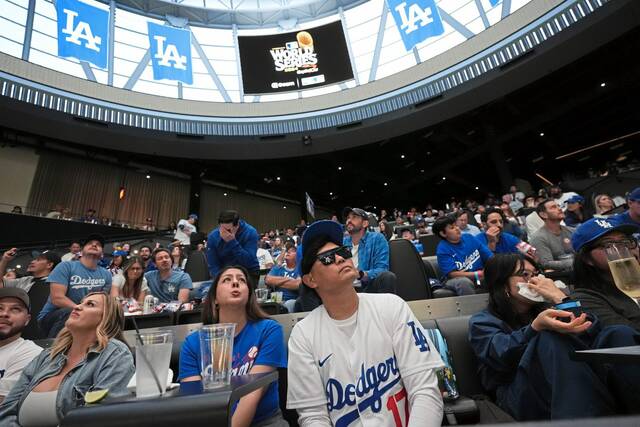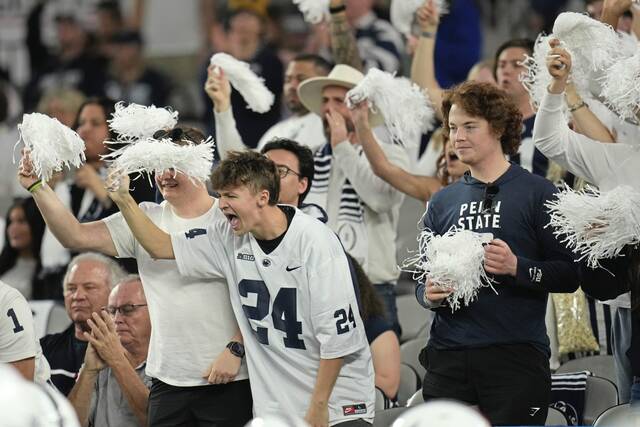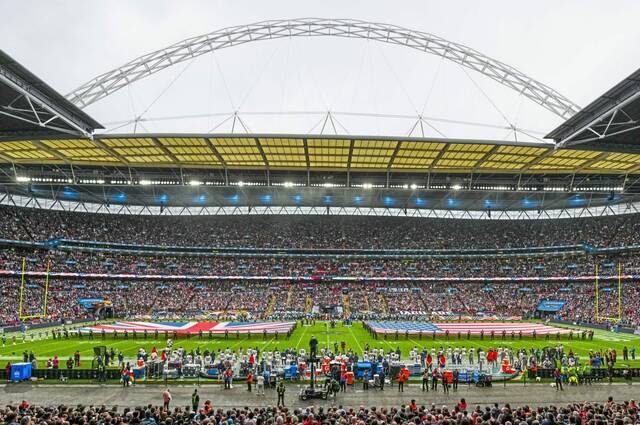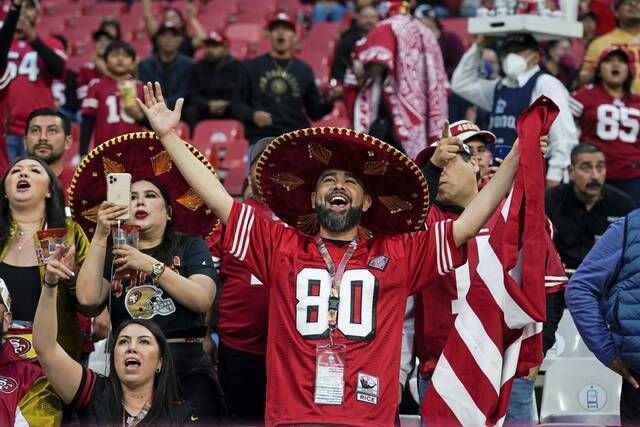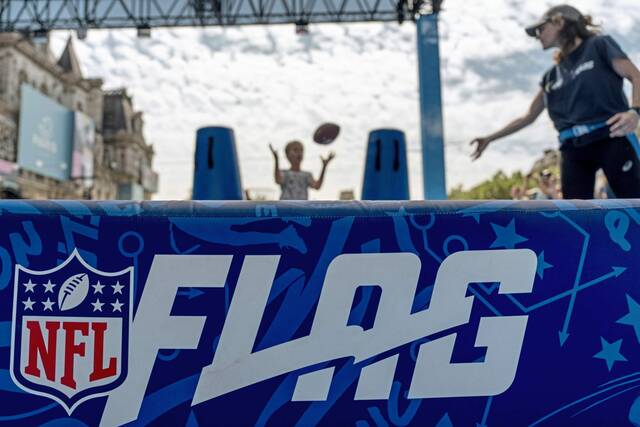Future of sports world integrates technology advancement, soaring revenue, fan experience
Editor’s note: One-fourth of the way through this century, TribLive is looking ahead to the next 25 years, using the events of the past 25 as a road map of what possibly is to come. This installment of the occasional series looks at the future of sports.
Payment to college athletes, a pitch clock in Major League Baseball and streaming platforms televising live events seemed as remote as a Pirates world championship when Y2K happened 25 years ago.
Imagine what sports will look like when the calendar flips to 2050 in another quarter century.
Experts predict that while the sports themselves will feature little change, technology and money will drive the future of games played at the pro and college levels.
Stadiums will be constructed with climate change and real estate investments in mind. Virtual reality will enhance the fan viewing experience. Women’s sports could grow exponentially.
“The future is so hard to project,” said Austin Karp, an editor/reporter for the Sports Business Journal, “but one thing we are confident in is that fans will consume sports in a completely different way.”
Consider that at the start of the century, smartphones weren’t in the pipeline to provide fans ways to connect with their teams, fantasy rosters and favorite leagues. The NFL, NHL and MLB didn’t have their own cable networks. Netflix was a DVD-by-mail rental service. Peacock was an NBC logo.
Social media didn’t exist, and opinions couldn’t be shared globally with a few clicks of the thumb. Those are staples of the current sports landscape and will only continue to grow.
“Younger fans want to have access to information, to be able to share their experience with people on social media,” said Dr. Patrick Rishe, director of the sports business program at Washington University in St. Louis. “Most venues have upgraded their connectivity to keep pace. They had to. I think you’ll see more opportunities for teams to find ways for fans to share on social and digital media.”
The challenge for sports teams in the future, experts say, will be to keep fans coming to the games and not take advantage of the home comforts created by high-definition TVs and streaming services that make almost any game available for live consumption.
Karp sees new stadium and arena construction being geared to providing fans with a bar/neighborhood atmosphere in mind.
“A lot of people are going to games not to watch,” he said. “It’s a social thing, to see and be seen. For a lot people — not the diehards — it’s like going to a bar and a game is also going on. I think you’ll see more fan-focused experiences.”
Fans first
Competition will come from companies such as COSM that aim to lure fans away from the venues and into their state-of-the-art viewing hubs. COSM has the viewing experience of a planetarium and IMAX theater rolled into one. Fans watch games on giant surround-sound screens that provide the feel of sitting courtside at an NBA game or in the end zone for a football event.
COSM has two facilities — one adjacent to SoFi Stadium in Los Angeles, the other in Dallas — and is set to expand into other markets this year. The cost is prohibitive — tickets to watch the Steelers-Bengals game this weekend, for instance, are priced at $110 at the Los Angeles venue.
The outlay is worth it, said Josh McHugh, CEO of Attention Span Media, a communications strategy firm.
“It’s the best sports event I’ve ever been to,” McHugh said. “It’s extremely immersive. You get great food and drinks, and it’s like being in the best owner’s box in the stadium.”
This is what Notre Dame's 98-yard opening TD looked like from Cosm in Los Angeles:pic.twitter.com/xDSqL7n6er
— Front Office Sports (@FOS) December 21, 2024
In 2016, McHugh spearheaded a study titled “The Future of Sports,” and the findings predicted an experience that included virtual reality. It just took longer for VR to take off than he expected.
“What was missing was that shared experience,” he said. “When you’re wearing that headset, you’re by yourself, you’re all alone. It just didn’t feel like you were actually at a sporting event. Now, you’re in there with up to 2,000 people. It’s like Buffalo Wild Wings meets the (Las Vegas) Sphere.”
Money matters
McHugh’s study eight years ago also predicted a landscape in which college athletes would be financially compensated. Thanks to NIL money being funneled to college athletes and a liberal transfer portal policy, the leverage has shifted from coaches and athletic directors to the players.
“It’s good for athletes who have been used to bringing in huge amounts of money into schools,” he said. “It’s not so great for non-revenue sports.”
Experts predict football and basketball programs, with their coffers being pumped up by NIL money provided by donors and private-equity investors, won’t want to give a piece of the financial pie to other college sports.
“The Olympic sports are going to be hurt the most,” Karp said. “We have to keep a pipeline going if we’re going to feed Team USA in a lot of these sports outside of basketball. If football takes all the money out of the system, you’re going to see Title IX implications, you’re going to see lawsuits. Congress is going to have to get involved.”
2050 look-ahead:
• Future of sports world integrates technology advancement, soaring revenue, fan experience
• Pennsylvania's influence may shrink in next 25 years as political winds shift
• Rise of the iPhone, social media 'opened up a new world' in 21st century
• Streaming changed how we view entertainment. The future may look a lot like the old model
Could the proliferation of college football, and the rise of super-conferences such as the SEC and Big Ten, lead to a dissolution of the NCAA? It has been predicted for years and may be close to fruition.
“It’s inevitable,” Karp said. “The rapid commercialization of college football will lead to some sort of breakaway. … I don’t know what the NCAA looks like in 25 years.”
The future of bowl games also is at risk with the implementation of the 12-team College Football Playoff. A quarter century ago, the Bowl Championship Series was in its infancy as a device used to determine a national champion. The conference structure also was different then. The Big East was a viable football and basketball entity.
Now, as the power conferences recruit new members — the Big Ten has 18 teams, the SEC 16 — schools such as Pitt and West Virginia might be fighting for inclusion in the next wave of realignment.
“It’s a game of musical chairs and who is going to be seated at the big boys’ table when it’s over,” Karp said.
Going global
Pro sports will continue to make investments abroad. It wasn’t until 2005 that the NFL played its first regular-season game outside the U.S. This year, five games were played in international markets, including the league’s first foray into Brazil.
The next quarter century will begin with the NFL conducting eight games outside the U.S., including one in Spain and an anticipated appearance by the Steelers in Ireland. Commissioner Roger Goodell envisions a time when the NFL will have 16 games — or nearly one a week — played internationally.
“We feel like this game is destined to be global,” Goodell told NFL.com. “We expect to be in Asia soon. We expect to be in Australia soon. We’re going to make sure our game is available around the globe.”
As for plans for sports leagues to place teams permanently outside the U.S. and Canada, technology will be an overriding factor. The Concorde ceased operations in 2003, but it may take that kind of supersonic jet for a team to be based permanently overseas.
“Until they invent a plane that can make the trip from Dallas to London in two hours, it’s not feasible,” Rishe said. “There are a lot of logistical issues that players would not necessarily be high on.”
Mexico City, with its closer proximity to southern states, could be a player in international expansion. It could lure current or expansion teams much the way Las Vegas has done in the past decade in hockey, football and, in 2028, baseball.
Building blocks
Construction of new stadiums and arenas will be done with the environment in mind. Because of climate change and hotter temperatures, the need for domed stadiums and other, smaller indoor facilities will be in demand.
“You cannot have sporting events in 120 degrees,” McHugh said. “There will be a lot more canopy setups, venues with roofs that open and close. It’s going to be more expensive to build because you’re going to have to cool them like you never have before.”
Real estate surrounding newly constructed sports venues will become part of the equation. SoFi Stadium, with COSM as one of its neighbors, has set the bar for what future sports venues can become.
“Sports franchises are going to become developers,” Rishe said. “The cat is out of the bag. They are looking to become a money-making machine year-round. They don’t want to make money just on the days the stadium is open. You can’t say it’s a new concept, but you’re going to continue to see it grow going forward.”
Growth spurts
Financial advisory firm Deloitte projected revenue in women’s sports to surpass $1 billion globally for the first time in 2024. If revenue reaches $1.3 billion as expected, it would be a 300% increase from 2021.
The WNBA, benefiting from the arrival of star rookie Caitlin Clark, is one of the fastest growing leagues from a financial perspective as valuations for its 12 teams have topped a combined $1 billion. The NSWL pro soccer league also has seen an uptick in revenue and popularity.
“The toothpaste is not going back into that tube,” Rishe said. “At some point, it’s going to level off, but now if you are involved in women’s sports as a fan, consumer, athlete or investor, this is your time to strike.”
In the past quarter century, the major sports leagues have added women to the fold in the front office as executives and on the field as assistant coaches. A female head coach in a men’s sport could become a reality in the next 25 years.
“You need the absolute best minds that you can get,” McHugh said. “If you rule out 50% of the population, you’re throwing a lot of opportunity out of the equation.”
Sports that were on the periphery in 2000 are now becoming mainstream. Pickleball had 39 known places to play in 2003, according to Pickleball Stuff, a website devoted to the sport. That number now exceeds 11,000, with pickleball being cited as America’s fastest growing sport in 2021-22.
Flag football is another growing entity. It will become an Olympic sport in the 2028 Games in Los Angeles. It helps that flag football has the backing of the NFL.
“Where tennis has pushed pickleball away, the NFL has gone in the opposite direction to promote the sport,” Karp said. “They see it as just football, something they are going to promote globally. If the NFL lets its athletes compete in the Olympics, it could be like what the Dream Team did for basketball.”
One sport that could be in decline in 25 years is the oldest in this country — baseball.
“That’s the one I would be worried about,” Karp said. “Baseball is making effort to try to make the game shorter, but it’s still really long and I just don’t know if the interest is there. It’s not going to be gone by any sense, but unless something changes, you’ll still have the haves and the have nots financially.”
The lack of a salary cap continues to amplify the difference between the competitive teams such as the World Series champion Los Angeles Dodgers and those such as the Pirates trying to end a 45-year title drought. MLB continues to be the only major sport without a cap.
“It’s not fair,” Karp said, “and if you don’t have one in baseball in 25 years, it’s probably doomed.”
Then again, those words were spoken by sports business experts in 2000, too.
Joe Rutter is a TribLive reporter who has covered the Pittsburgh Steelers since the 2016 season. A graduate of Greensburg Salem High School and Point Park, he is in his fifth decade covering sports for the Trib. He can be reached at jrutter@triblive.com.
Remove the ads from your TribLIVE reading experience but still support the journalists who create the content with TribLIVE Ad-Free.




